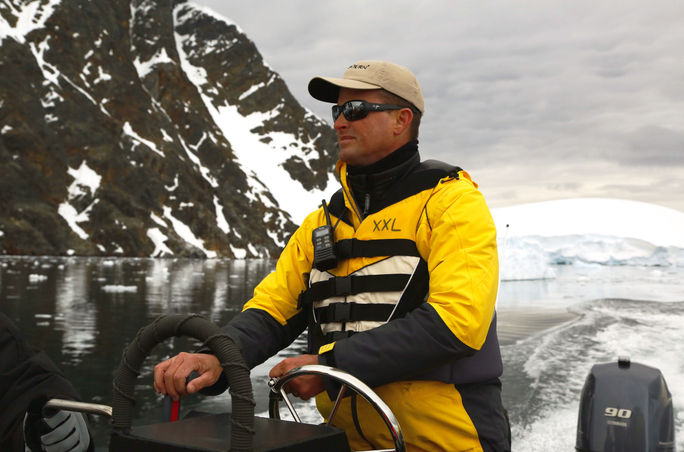Q&A with Seabourn’s Expedition Guru Robin West

Robin West, vice president and general manager of expeditions for Seabourn, spoke with TravelPulse aboard the 264-passenger Seabourn Venture, the ultra-luxury line’s first expedition ship built to sail in polar regions. West’s primary role is to oversee global expedition operations, most of which are included on the new expedition ships and available as shore excursions on the line’s traditional ocean-going fleet.
Our interview took place while we were sailing in Greenland, a voyage that let us explore this fascinating land by foot, Zodiac tours, kayaking and even underwater submersibles. A second expedition ship, Seabourn Pursuit, is expected to enter service in September 2023.
TravelPulse: Describe what you do in a nutshell.
Robin West: My job is to develop itineraries and manage expedition operations to deliver the best possible guest experience wherever we are in the world.
TP: Is this your dream job?
RW: One-hundred percent. This ship is my dream. I’ve been in the expedition industry for 20 years and came to Seabourn in 2013. My dad has always said to me that I’ve never worked a day in my life. He’s seen all the photographs of places I’ve been and things I’ve done. If I had to do it over again, I’d do the same thing.
TP: How do you plan where to go with the expedition ships?
RW: I have a team that supports me in deployment. I work with Jen Martin and Shaun Powell, and each of us have about 20 years of expedition experience for various companies. We take the ships to the favorite places we want to go and, based on where we’ve been and the experience in the industry, we tend to have covered the world quite well. We also know what this ship is capable of doing. When we built the ship, it needed to have autonomy to be able operate remotely for extended periods of time with no outside input or assistance. Beyond that, there’s obviously a much larger team that reviews the itineraries from a provisioning perspective and nautical perspective, as well as safety and access.
Both Pursuit and Venture are PC6 hull rated; PC stands for polar class. Basically, what that means is we’re not an ice breaker, but the ship is capable comfortably operating in ice up to 1.2, 1.3 meters thick. We can’t move through solid ice and create our own path like an ice breaker, but we can handle and operate very comfortably in a lot of ice. We took this ship last year up to 82 degrees north into the Arctic Circle in pack ice with no problem at all.
TP: What does this ship have that enables it to explore the Arctic and Antarctic regions?
RW: The ship is polar code rated, so that means everything on board is rated to a certain temperature; on this vessel it’s minus 10 degrees Celsius. It affects every technical aspect of the vessel to operate safely in those temperatures. We designed and built the vessel with operating in heavy ice in mind. It’s other little things. For example, on a typical ocean vessel, the tender platform opens onto the ocean, but nothing on Venture opens onto the water because if you’re in heavy pack ice, the ice has a chance of damaging it. All the shell doors open up or inwards.
We also have Azipod propulsion, which is fantastic in heavy ice conditions because you’ve got incredible control of the vessel, unlike shaft propellers where you can’t move as fast or as flexibly.
We designed this vessel with four cranes, so we can deploy two submarines, all the kayaking equipment, seven Zodiacs and two support vessels in 25 minutes. The submarines have a dedicated support vessel that accompanies them the entire time. We refer to them as a chase boat, and it’s in constant communication with the submarine, so it knows every single second where the submarine is. Each submarine, when it dives, has its own dedicated surface support boat.
TP: Does this ship have a computer-controlled dynamic positioning system (DPS), which allows the ship to stay in place without anchoring?
RW: Yes, it gives us the choice to anchor or not. Where we are now in Greenland, it’s just sand at the bottom and not a sensitive area. But if we are operating in a tropical coral reef area, this ship has a full dynamic positioning system so we don’t have to drop the anchor. It’s fantastic. It keeps the ship in place in up to 30-knot winds, so it’s very, very effective. And that’s another feature that allows us to operate in less-than-ideal conditions, because if we have swell or chop or a lot of wind, we use the ship to create a lee to load the Zodiacs safely.
TP: What was the most thrilling experience you’ve had on a Seabourn expedition?
RW: For me one of the highlights was last year’s inaugural sailing and naming ceremony in Antarctica. The plan was to put the ship into ice, disembark all the guests on the ice, and have the naming ceremony on the ice. After a couple of days of looking at the weather, we found a weather window where we thought we could make it happen. And so we sailed into the Weddell the night before and got where wanted to be at about midnight. We all woke up three hours later. The ice was starting to get a little soft in some places, so we had to take our time to find the right ice. By 7 o’clock, we put the ship in the ice, the sun came up, there wasn’t a breath of wind, our guests disembarked, and we did the entire ceremony exactly how we had planned it in the office six months before. It’s not often you can plan something theoretically in an office for Antarctica and it actually works.
